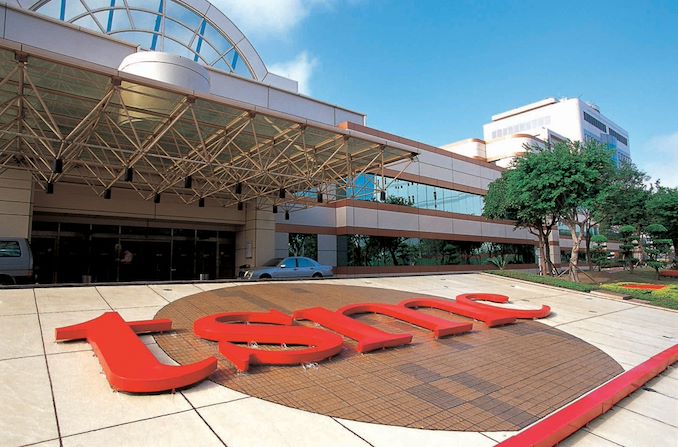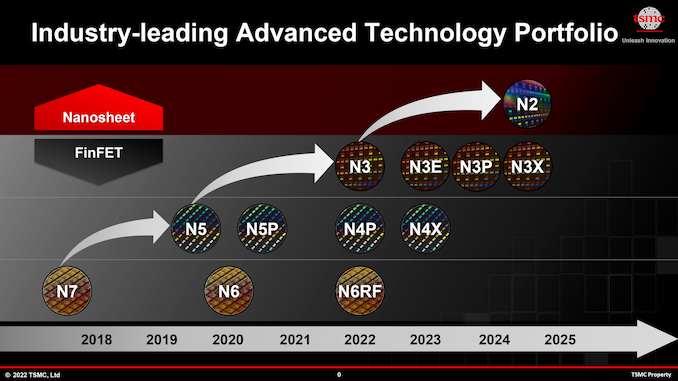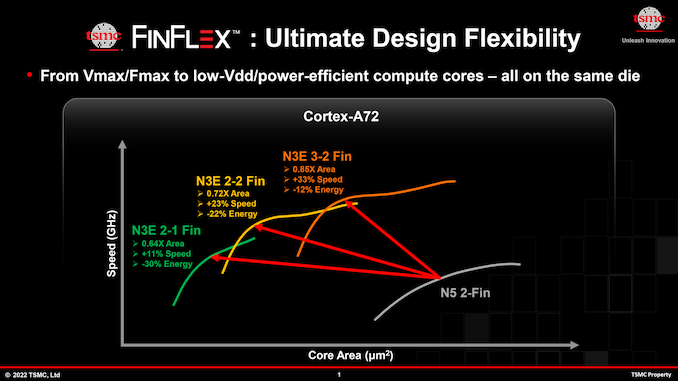TSMC Readies Five 3nm Process Technologies, Adds FinFlex For Design Flexibility
by Anton Shilov on June 16, 2022 3:10 PM EST
Taiwan Semiconductor Manufacturing Co. on Thursday kicked off its 2022 TSMC Technology Symposium, where the company traditionally shares it process technology roadmaps as well as its future expansion plans. One of the key things that TSMC is announcing today are its leading-edge nodes that belong to its N3 (3 nm class) and N2 (2nm class) families that will be used to make advanced CPUs, GPUs, and SoCs in the coming years.
N3: Five Nodes Over Next Three Years
As fabrication processes get more complex, their pathfinding, research, and development times get stretched out as well, so we no longer see a brand-new node emerging every two years from TSMC and other foundries. With N3, TSMC's new node introduction cadence is going to expand to around 2.5 years, whereas with N2, it will stretch to around three years.
This means that TSMC will need to offer enhanced versions of N3 in order to meet the needs of its customers who are still looking for a performance per watt improvement as well as transistor density bump every year or so. Another reason why TSMC and its customers need multiple versions of N3 is because the foundry's N2 relies on all-new gate-all-around field-effect transistors (GAA FETs) implemented using nanosheets, which is expected to come with higher costs, new design methodologies, new IP, and many other changes. While developers of bleeding-edge chips will be quick to jump to N2, many of TSMC's more rank & file customers will stick to various N3 technologies for years to come.
At its TSMC Technology Symposium 2022, the foundry talked about four N3-derived fabrication processes (for a total of five 3 nm-class nodes) — N3E, N3P, N3S, and N3X — set to be introduced over the coming years. These N3 variants are slated to deliver improved process windows, higher performance, increased transistor densities, and augmented voltages for ultra-high-performance applications. All these technologies will support FinFlex, a TSMC "secret sauce" feature that greatly enhances their design flexibility and allows chip designers to precisely optimize performance, power consumption, and costs.
| Advertised PPA Improvements of New Process Technologies Data announced during conference calls, events, press briefings and press releases |
||||||||
| TSMC | ||||||||
| N4 vs N5 |
N4P vs N5 |
N4P vs N4 |
N4X vs N5 |
N4X vs N4P |
N3 vs N5 |
N3E vs N5 |
||
| Power | lower | -22% | - | ? | ? | -25-30% | -34% | |
| Performance | higher | +11% | +6% | +15% or more |
+4% or more |
+10-15% | +18% | |
| Logic Area Reduction* % Logic Density* |
0.94x -6% 1.06x |
0.94x -6% 1.06x |
- |
? |
? |
0.58x -42% 1.7x |
0.625x -37.5% 1.6x |
|
| Volume Manufacturing |
2022 | 2023 | H2 2022 | 2023 | 2023 | H2 2022 | Q2/Q3 2023 | |
*Note that TSMC only started to publish transistor density enhancements for analog, logic, and SRAM separately around 2020. Some of the numbers still reflect 'mixed' density consisting of 50% logic, 30% SRAM, and 20% analog.
N3 and N3E: On Track for HVM
TSMC's first 3 nm-class node is called N3 and this one is on track to start high volume manufacturing (HVM) in the second half of this year. Actual chips are set to be delivered to customers in early 2023.This technology is mostly aimed at early adopters (read: Apple and the like) who can invest in leading-edge designs and would benefit from the performance, power, area (PPA) advantages offered by leading-edge nodes. But as it's tailored for particular types of applications, N3 has a relatively narrow process window (a range of parameters that produce a defined result), which may not be suitable for all applications in terms of yields.
This is when N3E comes into play. The new technology enhances performance, lowers power, and increases the process window, which results in higher yields. But the trade-off is that the node features a slightly reduced logic density. When compared to N5, N3E will offer a 34% reduction in power consumption (at the same speed and complexity) or an 18% performance improvement (at the same power and complexity), and will increase logic transistor density by 1.6x.
It is noteworthy that, based on data from TSMC, N3E will offer higher clockspeeds than even N4X (due in 2023). However the latter will also support ultra-high drive currents and voltages of above 1.2V, at which point it will be able to offer unbeatable performance, but with very high power consumption.
In general, N3E looks to be a more versatile node than N3, which is why it is not surprising that TSMC has more '3nm tape outs' at this point than it had with its 5 nm-class node at a similar point of its development.
Risk production of chips using N3E is set to start in the coming weeks (i.e., in Q2 or Q3 2022) with HVM set for mid-2023 (again, TSMC does not disclose whether we are talking about Q2 or Q3). So expect commercial N3E chips to be available in late 2023 or early 2024.
N3P, N3S, and N3X: Performance, Density, Voltages
N3's improvements do not stop with N3E. TSMC is set to bring out N3P, a performance-enhanced version of its fabrication process, as well as N3S, density-enhancing flavor of this node, some time around 2024. Unfortunately, TSMC is not currently disclosing what improvements these variants will offer compared to baseline N3. In fact, at its Technology Symposium 2022, TSMC did not even show N3S in its roadmap and it only got mentioned by Kevin Zhang in a conversation. Bearing all this in mind, it is really not a good business to try guessing characteristics of N3S.
Finally, for those customers who need ultra-high performance no matter power consumption and costs, TSMC will offer N3X, which is essentially an ideological successor of N4X. Again, TSMC is not revealing details about this node other than that it will support high drive currents and voltages. We might speculate that N4X could use backside power delivery, but since we are talking about a FinFET-based node and TSMC only going to implement backside power rail in nanosheet-based N2, we are not sure this is the case. Nonetheless, TSMC probably has a number of aces up its sleeve when it comes to voltage increases and performance enhancements.
FinFlex: N3's Secret Sauce
Speaking of enhancements, we should definitely mention TSMC's secret sauce for N3: FinFlex technology. In short, FinFlex allows chip designers to precisely tailor their building blocks for higher performance, higher density, and lower power.
Update 6/17: The initial version of the story incorrectly referred standard cells and blocks as transistors, which has been corrected.
When using a FinFET-based node, chip designers can choose between different libraries using different standard cells. A standard cell is the most basic building block that performs a Boolean logic or storage function and consists of a group of transistors and interconnects. From math point of view, the same function can be performed (with the same result) using a standard cell of different configurations. But from manufacturability and operation point of view, different standard cell configurations are characterized by different performance, power consumption, and area. When developers need to minimize die size and save power at the cost of performance, they use small standard cells. But when they need to maximize performance at the trade-off of die size and higher power, they use large standard cells.
Currently, chip designers have to stick to one library/standard cells either for the whole chip or the whole block in a SoC design. For example, CPU cores can be implemented using 3-2 fin blocks to make them run faster, or 2-1 fin standard cells to reduce their power consumption and footprint. This is a fair tradeoff, but it's not ideal for all cases, especially when we are talking about 3 nm-class nodes that will be more expensive to use than existing technologies.
For N3, TSMC's FinFlex technology will allow chip designers to mix and match different kinds of standard cells within one block to precisely tailor performance, power consumption, and area. For complex structures like CPU cores, such optimizations give a lot of opportunities to increase core performance while still optimizing die sizes. So, we are eager to see how SoC designers will be able to take advantage of FinFlex in the looming N3 era.
FinFlex is not a substitute for node specialization (performance, density, voltages) as process technologies have greater differences than the ibraries or transistor structures within a single process technology, but FinFlex looks to be a good way to optimize performance, power, and costs for TSMC's N3 node. Ultimately, this technology will bring the flexibility of FinFET-based nodes a little closer to that of nanosheet/GAAFET-based nodes, which are slated to offer adjustable channel widths to get higher performance or reduce power consumption.
Summary
Like TSMC's N7 and N5, N3 will be another family of long-lasting nodes for the world's largest contrast maker of semiconductors. Especially with the jump to nanosheet-based GAAFETs coming up at 2nm for TSMC, the 3nm family will be the final family of "classic" leading-edge FinFET nodes from the firm, and one that a lot of customers will stick to for several years (or more). Which, in turn, is why TSMC is prepping multiple versions of N3 tailored for different applications – as well as FinFlex technology to give chip designers some additional flexibility with their designs.
The first N3 chips are set to enter production in the coming months and arrive to the market in early 2023. Meanwhile, TSMC will keep producing semiconductors using its N3 nodes long after it introduces its N2 process technology in 2025.












43 Comments
View All Comments
dotjaz - Friday, June 17, 2022 - link
It's not like Samsung and Intel are far behind anyway. Worst case scenario Samsung and Intel can still produce something from last year.For example N4 isn't that much more advanced than Samsung's 4LPE. 10-15% better. Qualcomm never used this node. They renamed 5LPP to 4LPX.
Bruzzone - Friday, June 17, 2022 - link
Leeea, good point TSMC massive volume, "it is a matter of massive volume".I have not calculated TSMC component volume but will make that attempt. I am aware of Intel's 321 M in house + 100 M contract now moving to 521 M capable, moving to 621 M total by 2.8A and by the time Intel doubles PC&E cost line on CapEx would require 1 B units a year to sustain today's PC&E cost line at $162 per component produced. Also note Intel variable cost range $39 to $79 dependent on product line and range high $107ish is when Intel products get contracted out to foundries. Anything priced to the customer < variable cost.
TSMC average process density can be calculated and its 12 nm determined on the averages percent node contribution from 250 down to 5 nm. TSMC reports 13 M wafers annual. 53,000 mm2 that is an 75% yield means 698,000,000,000 mm^2 area of good silicon.
I don't have the data to state an average component area but will throw out Nvidia at 457 mm2, AMD dGPU at 411 mm2, AMD 7 nm CPU all up at 245 mm2, Intel I don't have a normalized currently lets just say Intel is competitive with AMD my quick % Xeon, Desktop, Mobile production around 230 and Intel likes 240 to 260 mm2 the quick average is 290.
TSMC average at half on all embedded say 150 mm2 average = 4.590 B TSMC components. Lets go to 100 mm2 corporations like round numbers = 6.890 B. And if all the little 25 mm2 embedded components say 75 mm2 average now = 9.186 B. The nice round number is TSMC at 10 billion components annual.
mb
tyb60 - Friday, June 17, 2022 - link
The scale and breadth across leading edge as well as legacy node at TSMC is a huge competitive advantage as well as fundamental anchor for the value of a foundry relationship to its customer.Intel has flawed believe that it can selectively pick foundry offering based on excessive capacity. One that capacity won't be trusted nor believed stable by potential customers. That alone will be a fundamental issue. Of course everyone will say they will use it, Nvidia, to get price leverage against their real supplier
Leeea - Thursday, June 16, 2022 - link
"the world's largest contrast maker of semiconductors"You mean largest contract maker of semiconductors?
del42sa - Friday, June 17, 2022 - link
"With TSMC FINFLEX™ in N3, product designers can choose the best FINconfiguration for each of these functional blocks, optimizing each block
without affecting others, all on the same die"
sounds amazing, even withouth using chiplets technology
TomWomack - Friday, June 17, 2022 - link
I would be very interested to know what was stopping product designers from mixing 2-1, 2-2 and 3-2 libraries previously: is it some kind of uniformity issue at the transistor level, where you want substantial blocks with the same 'texture' of gates and fins to avoid optical or measurement problems at intermediate spatial frequencies larger than transistors but smaller than SoC blocks.SiliconFly - Sunday, June 26, 2022 - link
FINFLEX is poor man's chiplet.Chiplets & tiles give full abstraction. Meaning, completely different engineering teams can work on their own tiles without any intervention from others. Theoretically.
Also, they can mix & match tiles (IP) at will. FINFLEX doesn't allow that. Just optimizes & enhances performance and power efficiency of a big monolithic die.
The real advantage is, if they can put FINFLEX into independent chiplets or tiles. But i don't think anyone wud choose to do that cos it makes the chiplet node or process dependent. Not worth the effort.
Silver5urfer - Friday, June 17, 2022 - link
So they are basically doing what Intel did for 14nm and 10nm. Yeah it's known that as the size decreases the complexity and cost rises sharply. Makes sense.AMD and Intel are the only ones when I see these lithography processes. ARM smartphone trash is basically useless after a year or max 3 years (stretching thin). So looking at AMD's details and TSMC, it's very clear on Node jumps are not going to be rapid. Thanks. Else I was getting tired of Apple's BS marketing nonsense.
Back to HW, AMD's Zen 5 is on 4nm, it's 2024-2025. So the N3 is not even relevant here, I bet it's more for a Smartphone node or Low Power one so Zen5 BGA junk. I wonder what RDNA4 and Nvidia Blackwell will be on, TSMC N3's high performance maybe, that's anyways post 2025.
So the biggest changes are going to come in 2025, Intel must move out of Intel 4, and go to 18A node and abandon their CORE design. AMD on the other hand will debut Zen 5 and up plans, Next Next Gen GPUs.
Samsung GAAFET, TSMC Nanosheet, Intel's RibbonFET are going to be the next high tech advancements.
So as of today highest volume is Intel 14nm is phased out slowly, Intel 7 or Intel 10nm replacing it by a huge margin, TSMC 7N+5N both (AMD and Nvidia GPUs plus AMD processors), even Apple's BGA on N5.
By 2025 maybe Intel 4 will take the spot for them, Samsung no idea honestly. TSMC N3.
edzieba - Friday, June 17, 2022 - link
I don't think Intel ever gave it a fancy marketing moniker like 'flexfin', but back when 10nm got its deep-dive in 2018 one of the features (in amongst all the other stuff that was crammed in the at the same time) was that all three transistor libraries libraries could add/remove one fin per transistor (as long as they were in the same poly line, because SAQP) in addition to regional library changes.ET - Saturday, June 18, 2022 - link
"FinFET-based noses"